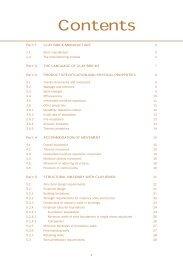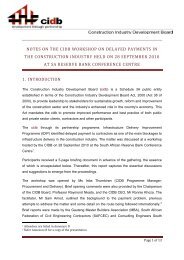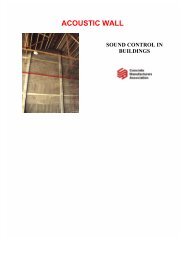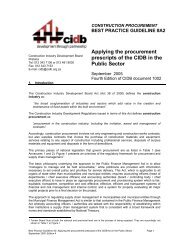MANUAL 4 - Construction Industry Development Board
MANUAL 4 - Construction Industry Development Board
MANUAL 4 - Construction Industry Development Board
Create successful ePaper yourself
Turn your PDF publications into a flip-book with our unique Google optimized e-Paper software.
<strong>MANUAL</strong> 4 – BITUMINOUS PAVEMENT SEALS<br />
• The concrete mixer operator and an assistant are responsible for measuring out the<br />
correct amount of cement and emulsion to be used, and he/she must also check the<br />
consistency of the mix. If too dry, the slurry already discharged must be returned to<br />
the mixer for further addition of water and mixing.<br />
Wheelbarrow operator’s duties:<br />
• They are required to fill the 25 litre cans or wheelbarrows with aggregate and deliver<br />
them to the mixer platform or hopper, ready for use.<br />
• They must place the barrows correctly at the discharge point below the drum of the<br />
mixer.<br />
• They must avoid any mud being carried onto the new work.<br />
• They must place the slurry with shovels just ahead of the squeegee operators in<br />
sufficient quantities for the squeegee operators to spread the material quickly and<br />
efficiently to a sufficient thickness. The slurry must be placed in approximately<br />
straight lines across the width of the area being treated, for relatively easy distribution<br />
by rubber squeegees.<br />
• During the process of shovelling the slurry from the barrow to the road, the shovels<br />
must be dipped into the drum of water and wiped with the wet mutton cloth.<br />
• Immediately when the barrow is empty, the barrow must be wiped with a wet cloth<br />
to remove any slurry sticking to the barrow as these eventually break loose and<br />
contaminate the slurry.<br />
• The barrow operators are responsible for site hygiene at the mixing site and road<br />
works site. Any spillage of slurry, emulsion or mud must be cleared, either by picking<br />
up the material and burying it or covering it up with gravel.<br />
• At the end of the shift, the operators must clean their equipment and help clean the<br />
mixer, as well as park the mixer in a safe place.<br />
– Two operators using the squeegees.<br />
– One operator cleaning any untoward spillage of slurry behind the screed and using<br />
the water hose.<br />
– Two operators laying the rails.<br />
– One operator on the mixer.<br />
– One operator measuring out cement, emulsion, water and diluting emulsion as<br />
required.<br />
5.2 Batching and mixing of slurry in concrete mixers<br />
• The area on which the concrete mixer and emulsion drum stand is situated must be<br />
clean, well drained and have a sound surface to avoid dirt and mud being carried onto<br />
the base by the wheelbarrows. It must also be kept clean during operations to avoid<br />
bitumen being carried on to the new work by the wheelbarrows.<br />
• The aggregate to be used in the slurry must be dumped as close to the working site as<br />
possible, preferably at the midpoint of the length of road that one load of aggregate<br />
will cover.<br />
• Using the measuring cans (Photo 4.37) add the correct amount of aggregate to the<br />
mixer drum, as determined by the engineer while the drum is turning. (Photo 4.38)<br />
IMPLEMENTING EMPLOYMENT INTENSIVE ROAD WORKS 61<br />
MODULE<br />
1<br />
2<br />
3<br />
4<br />
5<br />
6<br />
7












